Felicity met a man who told her Devil’s Lake has no inlets or outlets. Its level rises or falls depending on the amount of rain and snow. It was six feet higher a few years ago and in earlier times much of what is now lake was farmland.
The land up here is so flat that there’s little opportunity for drainage. The trees we passed that I thought had drowned did so, but not because of a change in the land, just because there was more snow than usual.
We stop in Rugby, geographic center of North America, to visit the Prairie Village Museum. Felicity first goes to the restaurant next door to sample home made pie and chat with locals. I ingest my formula.
An aside: I’m now a fan of the BiPap machine. Felicity says I sleep much more soundly. My airways feel better for the slightly moistened air and I assume my diaphragm enjoys the assistance.
The museum was great though it’s odd to find so many things that were part of my childhood and in some cases my younger adult life, too. The laundry equipment my mom used was so familiar and as for the tools in the blacksmith shop, well, I’m still using many of them. Never, even at my best, would I have needed a sausage maker quite so big as this one, though.
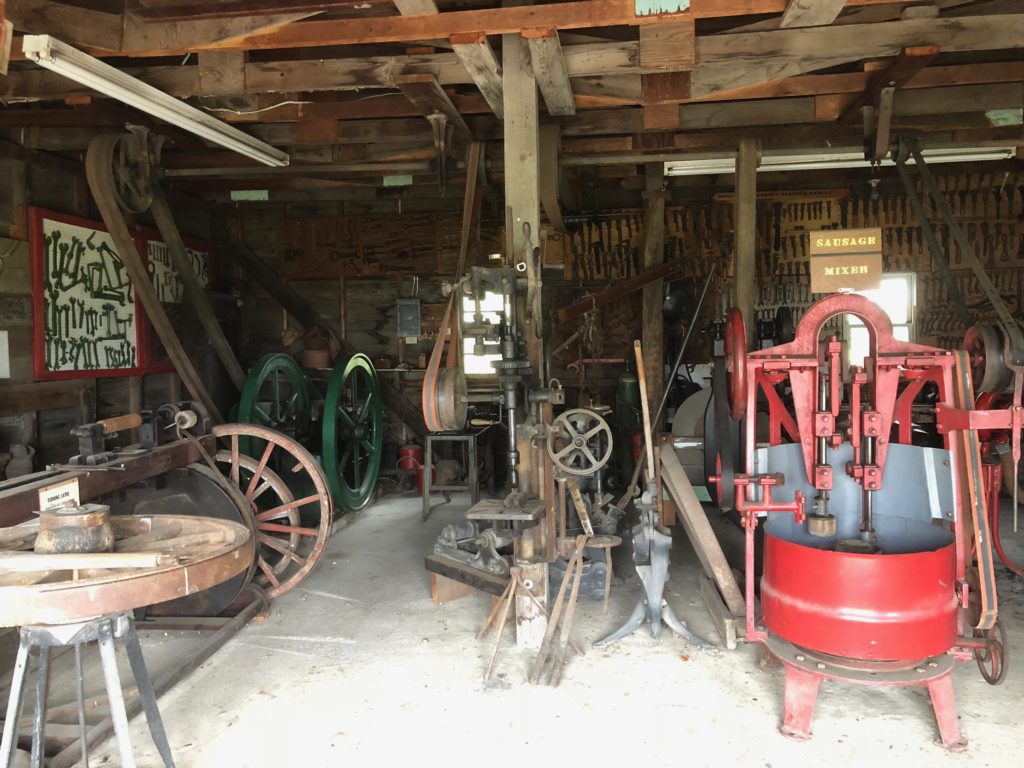
The school room was similar to the one in my village but mine had no blackboard and we used slates to write on because paper cost too much.
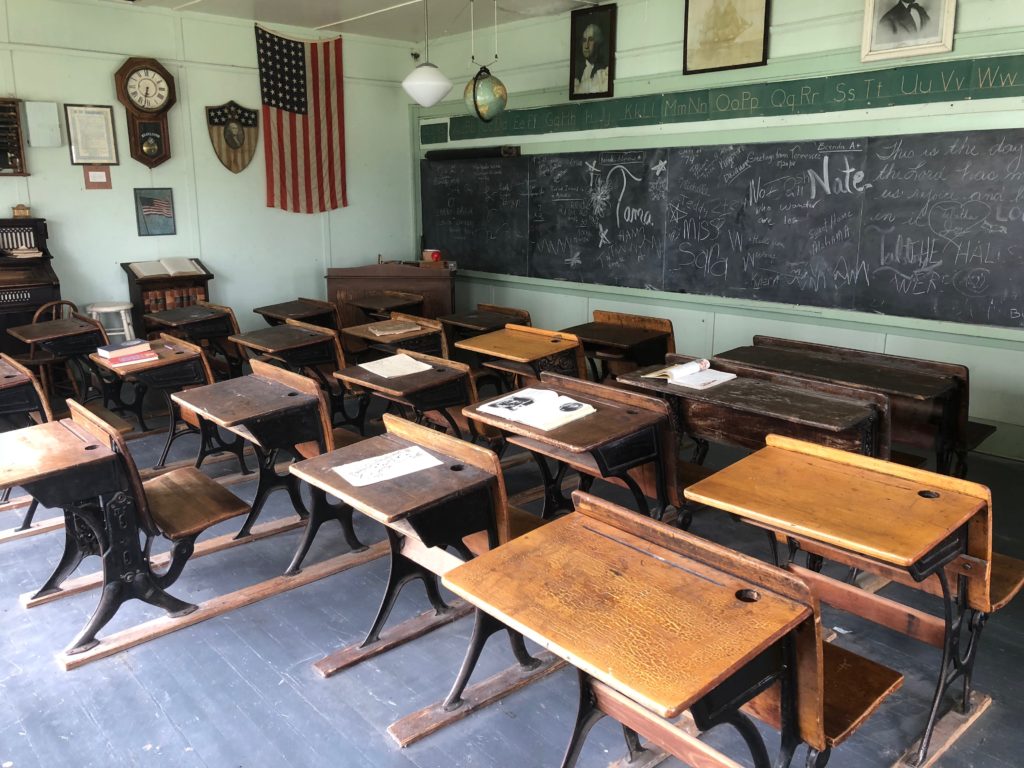
We were given a third of a pint of milk every day and lactose intolerance had not yet been recognized so I had to drink the milk, anyway. It was better in winter because I could put it up against the stove for a while to cook it. The pot-bellied stove here is surrounded by a protective barrier. The one in my school offered no such protection.
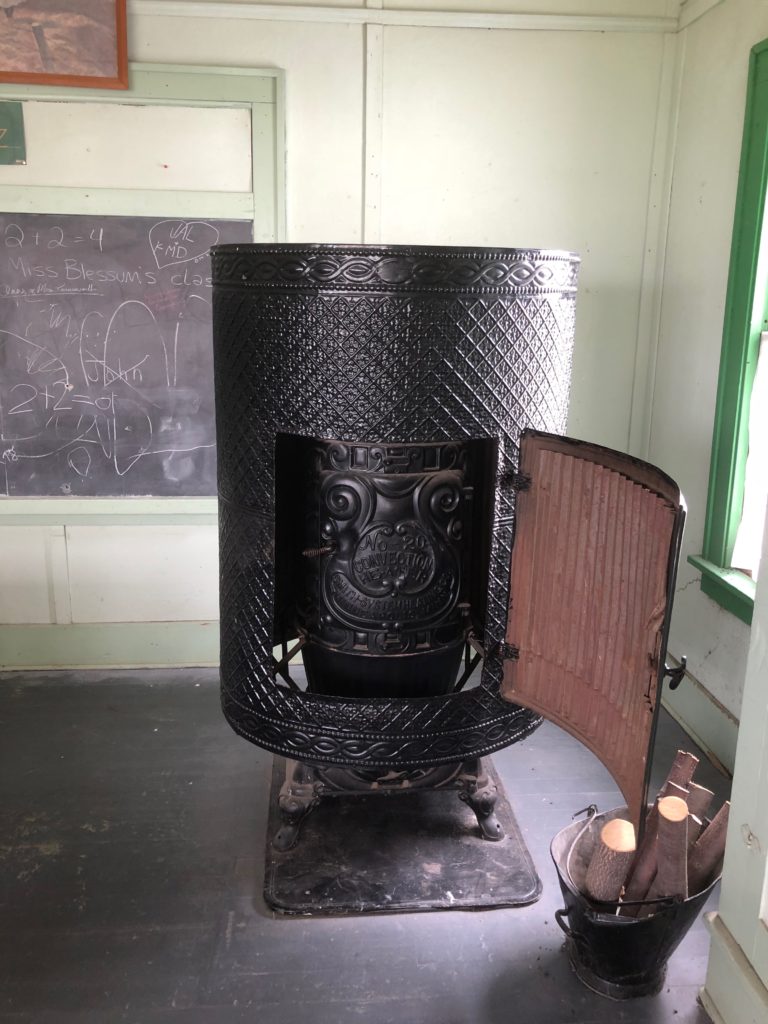
I enjoyed the farm machinery especially, of course. They have a traction engine belted up to a threshing machine. When I was a kid, pairs of them would go from farm to farm with a giant plow. They moved down either side of the field and hauled the plow back and forth between them. Very exciting. You can see part of the one here behind the magnificent yellow hay baler, most of which is made of wood.
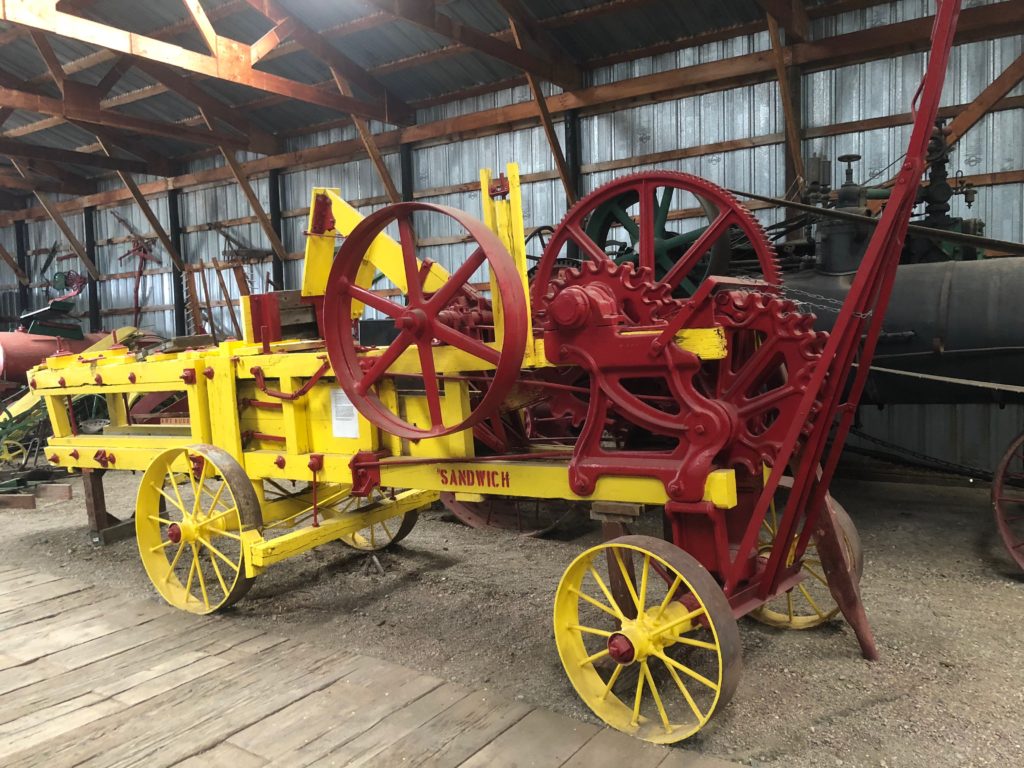
The soil in this part of the world is sufficiently friable and the fields are so huge that it was practical to pull plows behind the traction engines. Some of them were gigantic.
This area was settled to a large extent by Germans who had originally been given land in Russia by Catherine the Great. They were attracted here by the Homestead Acts of 1862 and later under which almost 10% of the total area of the US was given to 1.6 million homesteaders. The sandy loam here reminded the Germans of the Russian steppes. By 1960 they owned 45% of the land in this county.
The man on the desk tells us what Felicity had also been told earlier, that we should go next to the International Peace Garden. It’s only forty or fifty miles north of here, on the border between the US and Canada.
It was established in 1932 as a symbol of the peaceful relations between the two nations. That was the year FDR was elected President to lead us out of the Great Depression. It was a time when activists for peace and economic justice had powerful appeal.
So, here we are now at the campsite, nestled in a dense forest of white birches whose leaves are already yellow. There has been no frost here yet but it will come soon. It’s restful after a day of buffeting by wind.
Felicity asked if it’s always windy in N Dakota. “It is or it isn’t”. Sometimes the air is still, other times there’s a strong wind. It’s windy often enough that it’s been worthwhile to deploy many huge windmills.
We’ll investigate the garden in the morning then cross the border into Canada for the next stage of our journey west.
Next day – It’s pretty cold this morning. There are a couple of huge greenhouses filled with a great diversity of cacti at the Peace Garden. It seems bizarre in this location but their warm environment is appealing. The garden proper is excellent but we retreat quite quickly from the cold to the RV.
We head north to Brandon then west on the Trans-Canada Highway. We were advised it would be boring but we wanted to see it for ourselves.
This southern part of Manitoba and Saskatchewan looks a lot like North Dakota. Of course it does. The border is only man’s idea. As Felicity pointed out, everything we see here is this way because men made it so. There are signs in so many places telling us to be careful to preserve the habitat by not introducing invasive species. But all these crops are invaders. Humankind is the ultimate invasive species.
The high point on our drive to tonight’s campsite just east of Regina was a field of grazing bison. Why didn’t I take a picture!
This campsite next to the highway is almost full despite it being the end of tourist season. Most of the people here are working on the pipeline. It’s like drawing up in our covered wagon to a temporary settlement of railroad pioneers long ago.
A random observation: we saw some overweight people in Minnesota and North Dakota but none of the grossly overweight ones that are so common back east. I wonder why?
Health update: I’m learning to manage my drooling/dryness and my coughing. I was still taking saliva reduction meds while the botox injection took effect and my excessive dryness was because I kept doing that too long. I stopped the meds altogether yesterday. There was a bit too much saliva but I was less prone to coughing. I struck a better balance today but I need to experiment about the time of day to take or not take the meds. It’s also very effective to keep a thick tissue over my mouth to avert coughing. It looks funny but from my point of view at any rate it’s very much worthwhile.
Snow is forecast for Jasper by the time we get there later this week. We’ll go, anyway.
We drive into Regina to visit the Governor’s museum where we’re guided by a charming and vivacious docent from Quebec. She and Felicity exchange information, Felicity explaining the science and usage of the English toast rack.
We read of treaties where the First Nation traded their land for health, education and other services in perpetuity from the fledgling Canadian government. Our docent says the reality is rather more complicated. Nonetheless, the people of the First Nation do seem to have been better treated by the Canadian government which feared uprisings by them than Native Americans were by the US government. They could hardly have been treated worse.
Then we continued west. After around a hundred kilometers the gigantic, flat harvested fields begin to be interspersed with low, rolling grass covered hills.
After maybe another hundred kilometers we see brilliant white rows and heaps that look like old snow. It appears to have washed or been pushed downhill from an area of digging. It is potash mixed with salt.
Potash mining is a major industry here. Almost all of it is used to make fertilizer which I guess is very important because this soil is sandy and it does not look very fertile.
Another hundred kilometers on there are many fewer cropped fields and much more grassland. Some of it is hayed but the big round bales that are left in the fields are quite few and far between.
As we drive on, the grassland grows steadily poorer. Many fields have been taken over by what looks like tumbleweed. Beef cattle spread out looking for anything worth eating.
There are quite a few ponds and some lakes, all very shallow looking. Cattle are gathered in a dried up one too far from the road for us to sure but it seems they are licking salt off the pond bed.
We pass so many trains. Pairs of locomotives with sometimes a third one in the middle of dozens upon dozens, maybe hundreds of freight cars.
We also see one relatively spiffy locomotive pulling two passenger cars and I remember spending many hours as a kid with a book about the Canadian Pacific Railway, enchanted by pictures of the train barreling through the Rockies.
The Railroad’s headquarters is a bit further west from here in Calgary. The railroad was how immigrants came to the Prairie lands. Set up in the early 1880s, it was how Canada’s western territory was opened up.
We camp just outside Medicine Hat, Alberta and are glad Felicity packed a small electric heater with a fan.
Next day – In the morning Cousin Alison asks if we’re going to Head-Smashed-In Buffalo Jump. Having never heard of it we weren’t, but now we are. It’s around 3 hours west of here at our 55 mph pace.
The land flattens again west of Medicine Hat. Many of the fields are irrigated by the gigantic wheeled sprinklers that rotate round a water supply making those huge round fields you see from the air.
Every so often yesterday and today we pass an oil pump, usually in the middle of a field. A few continue pumping slowly as if they’ve been doing it way too long.
We pass a couple of fields of corn. I’ve heard it grows as high as an elephant’s eye in Oklahoma. For that to be true up here, the elephant would need to be lying down.
Head-Smashed-In Buffalo Jump is where buffalo were “harvested” by stampeding them over a cliff. A too-eager participant is said to have had his head smashed in by going too close to where the buffalo fell.
Buffalo grazed on these vast prairies and some would wander within range of the invisible drop. They have an excellent sense of smell but poor eyesight. Men would dress in wolf skins and, much like sheepdogs, herd them toward the cliff.
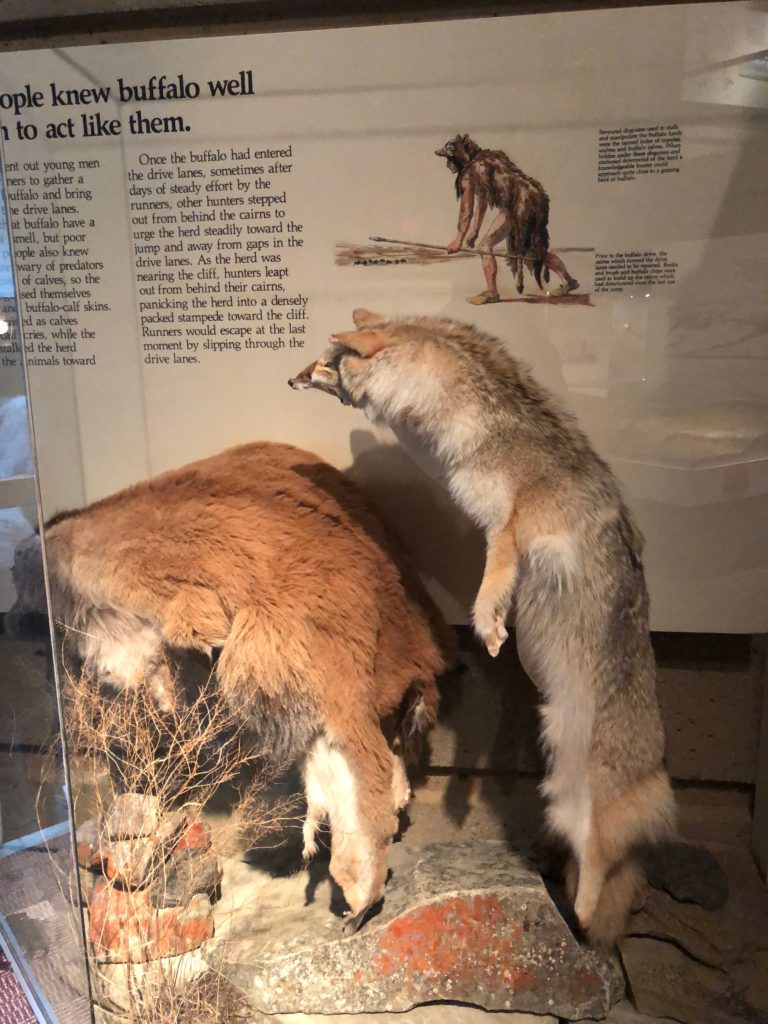
Buffalo are led by females whose top priority is safety of the calves so, to complement the threat from pretend wolves, a man in a buffalo hide would pretend to be a calf wandering away in the direction of the cliff. The herd would follow to bring it back among them.
When they were close enough to the cliff, many other men, hidden and dressed in buffalo hides to mask their smell, would leap up and yell to panic the herd. Unable to stop because of the pressure of those behind them, the panic-stricken beasts would tumble to their death. The waiting butchers and cooks would then begin work. They dried the meat, got the marrow out of the bones, stored the fat in bladders, cured the hides and used the bone for needles. There was also, of course, a great feast. The stuffed ones on display might not have fallen for the trap because they can see the cliff edge.
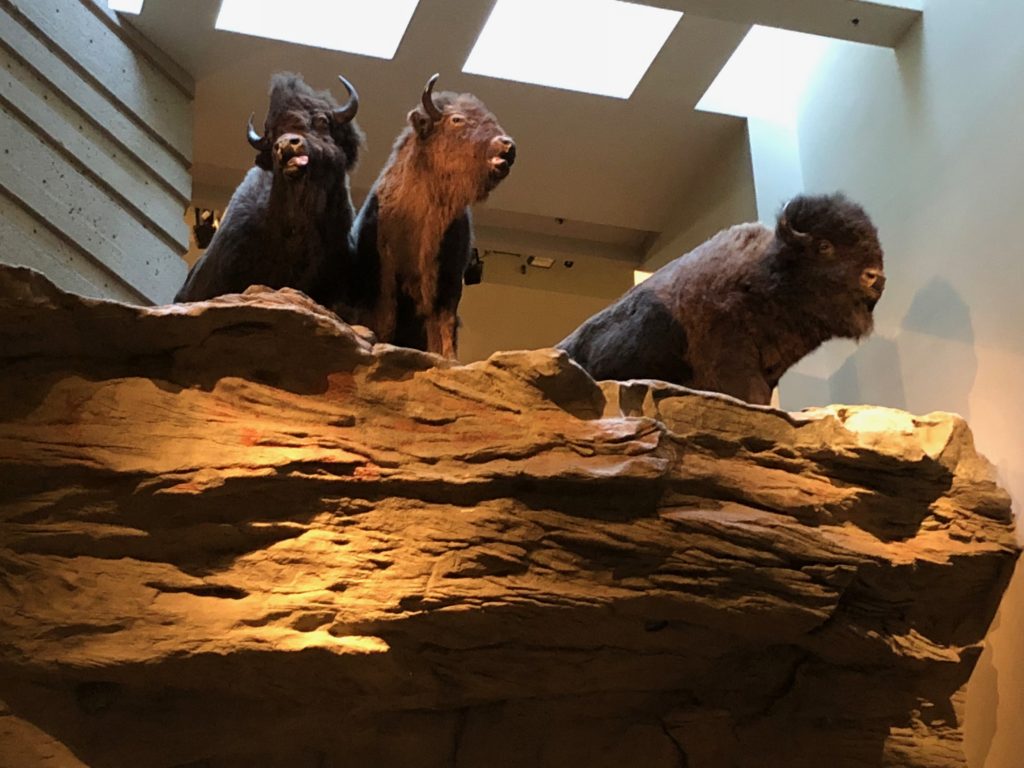
We felt sad for the buffaloes. The interpretation film recreating the massacre has the protagonists say the bounty demonstrates that they are loved and cared for by the higher powers. Perhaps all hominids have justified their acts in this way. Or maybe this is how white men think and we assume everyone else does, too.
The Blackfoot hunters were doing this long before they had guns. I don’t know when they stopped. Native Americans in the US switched to hunting on horses in the 17th century, I think. It’s estimated there were 30 million bison on the Great Plains in the early 1800s but they had almost all been wiped out by mid-century, primarily by government sponsored slaughtering to drive out the Native Americans who depended on them for food. The Blackfoot practice left the herds intact.
We’re too tired to take the trail to where the buffalo bones were found. Felicity looks for a nearby campsite and there’s one beside a lake so of course she proposes that one. We have no trouble getting a site on the lake shore because there’s nobody else here. It’s getting cold.
We’ve come almost 3,000 miles so far, driving every day, so it feels time for a day of rest tomorrow.
